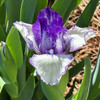Iris x germanica 'Rare Edition' - TALL BEARDED IRIS 'RARE EDITION'
Intermediate Bearded Iris, reaching 24".
Plicata type - white background with purple-blue, no fragrance.
Holds several awards.
Good to divide after several years of growing.
Blooming Time: April/May with
Size: 24" tall x 18-24" wide
USDA Zones: 3 to 9
Culture: full sun, half shade (afternoon shade in hot climates). adaptable to many soil types that stay medium to dry (including clay, including shallower, rocky, sandy soils). Some organic matter is beneficial for stronger blooming.
Moisture Needs: dry to medium
Origin: Selected by Joseph Gatty, R. in 1980)
Deer/Rabbit Resistant: yes / yes
Attracts Butterflies or Pollinators: no
Attracts Hummingbirds: no
Pot Size: 3.5" x 4" perennial pot
Plant combinations: Goes well with most perennials, good companions can be plants with smaller leaves like Amsonia, Aster (A. novae-angliae, A. laevis, A. oblongifolius), Asclepias tuberosa, Baptisia, Echinacea (E. angustifolia, pallida, paradoxa, tennesseensis), Penstemon, Rudbeckia, Monarda fistulosa, Salvia, etc and many grasses.
Picture copyright: US Perennials

Iris x germanica 'Rare Edition' - TALL BEARDED IRIS 'RARE EDITION'
Intermediate Bearded Iris, reaching 24".
Plicata type - white background with purple-blue, no fragrance.
Holds several awards.
Good to divide after several years of growing.
Blooming Time: April/May with
Size: 24" tall x 18-24" wide
USDA Zones: 3 to 9
Culture: full sun, half shade (afternoon shade in hot climates). adaptable to many soil types that stay medium to dry (including clay, including shallower, rocky, sandy soils). Some organic matter is beneficial for stronger blooming.
Moisture Needs: dry to medium
Origin: Selected by Joseph Gatty, R. in 1980)
Deer/Rabbit Resistant: yes / yes
Attracts Butterflies or Pollinators: no
Attracts Hummingbirds: no
Pot Size: 3.5" x 4" perennial pot
Plant combinations: Goes well with most perennials, good companions can be plants with smaller leaves like Amsonia, Aster (A. novae-angliae, A. laevis, A. oblongifolius), Asclepias tuberosa, Baptisia, Echinacea (E. angustifolia, pallida, paradoxa, tennesseensis), Penstemon, Rudbeckia, Monarda fistulosa, Salvia, etc and many grasses.
Picture copyright: US Perennials


